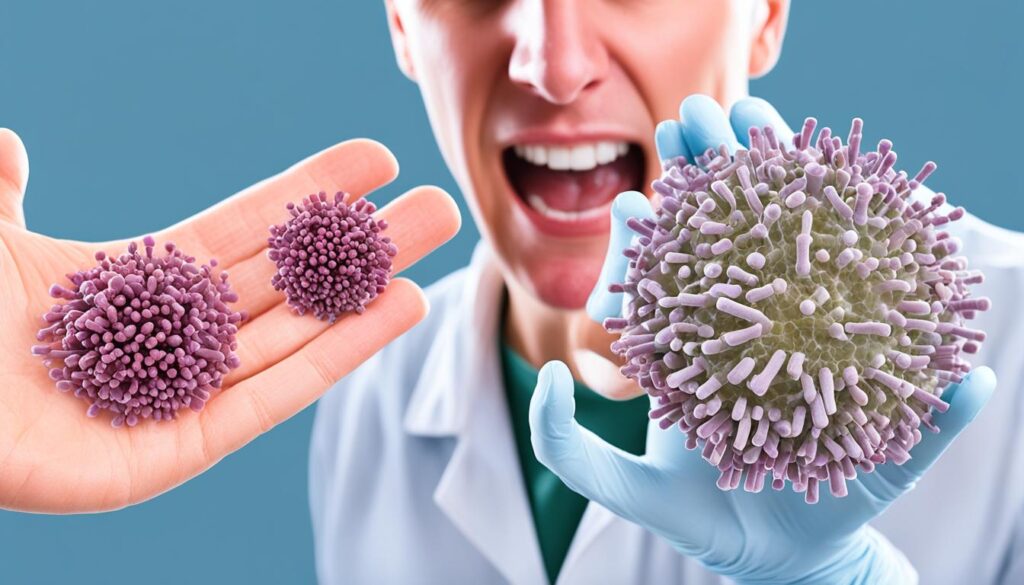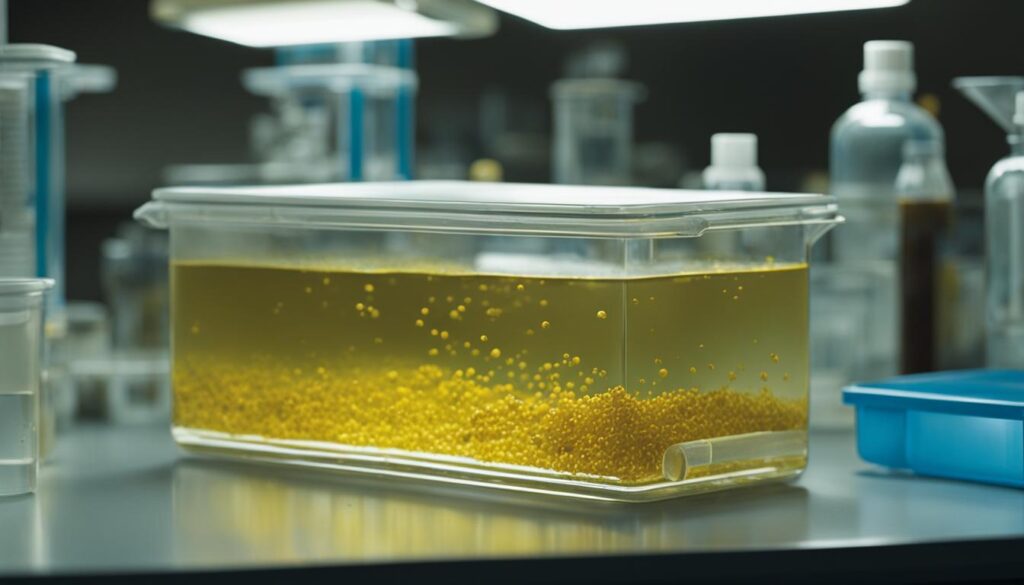Did you know that the stomach bug, also known as gastroenteritis, affects millions of people worldwide every year? In fact, it is estimated that the stomach bug is responsible for over 179 million cases of acute gastroenteritis annually in the United States alone. This highly contagious infection of the digestive system can cause a range of uncomfortable symptoms and can greatly impact your day-to-day life.
Understanding the symptoms of the stomach bug in 2024 is crucial for timely identification and effective management of the virus. Whether you’re experiencing vomiting, diarrhea, abdominal pain, or nausea, recognizing the signs early can make a significant difference in preventing the spread of the infection and getting the necessary treatment.
In this article, we’ll explore the common symptoms associated with the stomach bug, specifically in 2024. We’ll also delve into the specific signs that indicate a norovirus infection, the primary cause of the stomach bug. By the end, you’ll have a comprehensive understanding of the symptoms to watch out for and the steps you can take to protect yourself and others from this prevalent gastrointestinal illness.
Key Takeaways:
- The stomach bug, or gastroenteritis, affects millions of people worldwide each year.
- The stomach bug is responsible for over 179 million cases of acute gastroenteritis annually in the United States.
- Recognizing the symptoms of the stomach bug in 2024 is essential for the timely identification and management of the virus.
- Understanding the specific signs of norovirus, the primary cause of the stomach bug can help in preventing its spread.
- By following proper hygiene practices and taking necessary precautions, you can protect yourself and others from the stomach bug.
Introduction to Norovirus 2024: The Stomach Bug Spreading Across Northeastern US
Norovirus 2024, also known as the stomach bug, has been spreading rapidly across the northeastern United States, causing concern among health officials and communities. This highly contagious virus has led to a surge in cases, particularly in New Jersey, where its impact on schools and community health is becoming more evident.
The Rise of Norovirus Cases in New Jersey
New Jersey has experienced a significant increase in norovirus cases, with reports of outbreaks in schools, nursing homes, and other public places. The rise in cases can be attributed to various factors, including the highly contagious nature of norovirus and its ability to spread rapidly in close quarters.
In schools, where students and staff often come into close contact, norovirus can spread quickly. Shared surfaces, such as doorknobs, water fountains, and cafeteria tables, can serve as breeding grounds for the virus. Proper hygiene practices and frequent disinfection of these surfaces are crucial in limiting the spread of norovirus in educational settings.
Impact on Schools and Community Health
The increase in norovirus cases has had a significant impact on schools and community health in New Jersey. Schools have had to implement measures such as temporary closures, increased sanitation, and education on proper hand hygiene to contain the spread of the virus.
The impact of norovirus goes beyond schools, affecting the entire community. Outbreaks in restaurants, nursing homes, and other public places have resulted in closures, loss of revenue, and compromised public health. The need for enhanced awareness and prevention strategies is crucial to mitigate the transmission of norovirus.
To help track the spread of norovirus and stay informed about outbreaks in your area, there are resources available, such as the norovirus 2024 outbreak map. This map provides real-time updates on reported cases and helps individuals and communities take necessary precautions to prevent further transmission.
We must remain vigilant in our efforts to prevent the spread of norovirus. By practising good hygiene, such as washing hands frequently, avoiding close contact with infected individuals, and disinfecting surfaces, we can help protect ourselves and our communities against this stomach bug.
Understanding Norovirus: The Culprit Behind Gastroenteritis
Norovirus is the specific virus responsible for causing gastroenteritis, commonly known as the stomach bug. It is a highly contagious virus that spreads rapidly, particularly in crowded settings such as schools, hospitals, and cruise ships. Understanding the characteristics of norovirus is essential in preventing and managing its transmission.
Norovirus is primarily transmitted through the fecal-oral route, meaning it spreads when people ingest tiny particles of the virus from contaminated food, water, or objects. The virus can survive on surfaces for extended periods, making it crucial to practice proper hygiene and disinfection.
The impact of norovirus on the gastrointestinal system is significant. The virus targets the lining of the stomach and intestines, leading to inflammation and disruption of normal digestive processes. This can result in symptoms such as vomiting, diarrhea, abdominal pain, and nausea.
Common symptoms of norovirus infection include:
- Projectile vomiting
- Watery diarrhea
- Abdominal cramps
- Nausea
- Fever
- Headache
- Muscle aches
- Fatigue
It is important to note that norovirus can cause severe dehydration, especially in young children and older adults. If you or someone you know experiences persistent vomiting or diarrhea, it is crucial to seek medical attention for proper evaluation and treatment.
By understanding the nature of norovirus and its associated symptoms, we can take necessary precautions to prevent its spread and protect our health.
What Are the Symptoms of the Stomach Bug 2024
To effectively manage and prevent the stomach bug in 2024, it is crucial to be able to identify the symptoms associated with this viral infection. While the symptoms may vary from person to person, there are common signs that can indicate a stomach virus infection. These symptoms include:
- Vomiting
- Diarrhea
- Abdominal pain
- Nausea
These are the general symptoms that can occur with any stomach virus. However, there are also specific signs that are more indicative of a norovirus infection, which is the primary cause of the stomach bug in 2024. These symptoms include:
- Dehydration
- Loss of appetite
- Fatigue
- Projectile vomiting
- Watery diarrhea
It is important to recognize these symptoms early on as they can help in seeking timely medical intervention. By understanding the symptoms of the stomach bug in 2024, individuals can take appropriate measures to prevent the spread of the virus and alleviate discomfort.
The Transmission of Norovirus: How the Stomach Bug Spreads
Norovirus, the culprit behind the stomach bug, is known for its highly contagious nature. Understanding how this virus spreads is crucial in preventing its transmission and protecting yourself and others from infection.
There are several ways in which norovirus can be transmitted:
- Person-to-person contact: Close contact with an infected individual, such as shaking hands or sharing utensils, can result in the transfer of the virus.
- Ingestion of contaminated food or water: Consuming food or water that has been contaminated with norovirus is a common route of transmission. This can occur when food is prepared by an infected individual or comes into contact with contaminated surfaces.
- Contact with contaminated surfaces: Norovirus can survive on surfaces for extended periods. Touching objects or surfaces contaminated with the virus, such as doorknobs or countertops, and then touching your face or mouth can lead to infection.

Proper hygiene practices play a crucial role in preventing the spread of norovirus. Regularly washing your hands with soap and water for at least 20 seconds is one of the most effective ways to reduce the risk of infection. Paying attention to high-touch surfaces and frequently disinfecting them can also help eliminate the virus.
While norovirus is highly contagious, it is important to note that there are effective sanitizing agents and practices that can kill the virus. Using a bleach-based disinfectant or a disinfectant registered with the Environmental Protection Agency (EPA) can help in the eradication of norovirus on surfaces.
By understanding how norovirus spreads and taking appropriate preventive measures, you can significantly reduce the risk of infection and help prevent the stomach bug from spreading further.
Peak Season for Norovirus: When to Be Most Vigilant
Understanding the seasonal patterns of gastrointestinal illnesses, including norovirus, is crucial in determining when to be most vigilant. Norovirus, commonly known as the stomach virus, exhibits specific peak seasons when its prevalence is highest. By being aware of these peak seasons, individuals can take appropriate preventive measures to minimize the risk of infection. Let’s explore the seasonal patterns of gastrointestinal illnesses and the importance of staying informed about the current stomach virus outbreak map.
Seasonal Patterns of Gastrointestinal Illnesses
Gastrointestinal illnesses, such as norovirus, often show cyclic patterns throughout the year. While the exact timing may vary depending on geographic location, certain seasons tend to experience a higher incidence of these infections. In general, norovirus cases tend to spike during the winter months, particularly from December to February. Cold weather and increased indoor activities during this time create favorable conditions for the virus’s spread, leading to more cases of stomach bug.
However, it is important to note that norovirus infections can occur throughout the year, even outside the peak seasons. Outbreaks can occur in various settings, including schools, healthcare facilities, cruise ships, and households. Therefore, maintaining good hygiene practices and staying vigilant about preventive measures is crucial year-round.
Current Stomach Virus Outbreak Map
To stay informed about the latest outbreaks and track the spread of the stomach virus, individuals can rely on the current stomach virus outbreak map. This map provides valuable information on the geographic distribution of norovirus cases, helping individuals identify regions with higher infection rates. By staying updated with the current stomach virus outbreak map, individuals can assess the risk levels in their area and take appropriate precautions to protect themselves and their communities.
| Benefits of Using the Current Stomach Virus Outbreak Map |
|---|
| 1. Enables early identification of high-risk areas |
| 2. Helps individuals plan to travel to minimize exposure |
| 3. Enhances awareness of the stomach virus’s spread |
| 4. Assists in implementing targeted preventive measures |
By leveraging the information provided by the current stomach virus outbreak map, individuals can make informed decisions to protect themselves and their loved ones.
In conclusion, understanding the peak seasons for norovirus and staying informed about the current stomach virus outbreak map are essential in preventing and managing the spread of the stomach bug. By being vigilant during the peak seasons and following appropriate preventive measures, individuals can minimize the risk of norovirus infection and contribute to maintaining community health.
Effective Norovirus Prevention Strategies
Hygiene Practices to Mitigate Infection Risk
Preventing norovirus infection starts with practicing good hygiene. By adopting the following measures, you can significantly reduce the risk of contracting and spreading the virus:
- Regularly wash your hands with soap and water for at least 20 seconds, especially before eating or preparing food, after using the bathroom, and after coming into contact with potentially contaminated surfaces. This helps remove any norovirus particles that might be present on your hands.
- Avoid close contact with individuals who are infected with norovirus or showing symptoms of the stomach bug.
- Make sure to thoroughly cook shellfish and other seafood before consumption, as norovirus can survive at low temperatures.
- Clean and disinfect contaminated surfaces, especially in high-risk areas such as kitchens, bathrooms, and common gathering areas. Follow the guidelines for surface disinfection detailed below.
- Dispose of contaminated items, including soiled clothing and bedding, properly and promptly.
- Avoid sharing personal items such as utensils, towels, and drinking glasses with infected individuals.
Guidelines for Hand Washing and Surface Disinfection
Proper handwashing is essential in preventing the spread of norovirus and other infectious diseases. Follow these guidelines to ensure effective hand hygiene:
- Wet your hands with clean running water and apply soap.
- Rub your hands together to create a lather, covering all surfaces including the backs of your hands, between your fingers, and under your nails.
- Continue rubbing your hands for at least 20 seconds.
- Rinse your hands thoroughly under running water.
- Dry your hands with a clean towel or air dry them.
To effectively disinfect surfaces and eliminate norovirus, follow these guidelines:
| Surface | Disinfection Procedure |
|---|---|
| Kitchen Countertops | Use a disinfectant approved for use against norovirus. Apply the disinfectant and let it sit for the recommended contact time before wiping it off. |
| Bathroom Surfaces | Use a disinfectant recommended for use in bathrooms. Follow the manufacturer’s instructions on contact time and application. |
| High-touch surfaces (e.g., doorknobs, light switches) | Disinfect these surfaces regularly using an appropriate disinfectant. Pay extra attention to areas frequently touched by multiple individuals. |
| Clothing, Bedding, and Linens | Wash these items in hot water with detergent. Use the highest heat setting possible for drying. |
By following these simple guidelines for handwashing and surface disinfection, you can effectively reduce the spread and transmission of norovirus, protecting yourself and those around you from the stomach bug.
Is There Treatment or a Vaccine for Norovirus in 2024?
If you’re wondering about the availability of treatment or a vaccine for norovirus in 2024, we have the information you need. While there have been advancements in research and development efforts to prevent norovirus, there is currently no specific antiviral medication or vaccine available to treat or prevent this stomach bug.
Research Developments in Norovirus Prevention
Scientists and medical professionals are actively studying norovirus to better understand its mechanisms and develop effective preventive measures. Ongoing research aims to identify potential targets for antiviral drugs and vaccines. However, it is crucial to note that the development and approval of new treatments or vaccines can be a lengthy process that requires rigorous testing and evaluation.
Understanding the Limitations of Treatment Options
When it comes to treating norovirus, the primary focus is on supportive care to manage the symptoms and promote recovery. This includes staying hydrated to prevent dehydration, getting enough rest, and following a bland diet to ease gastrointestinal discomfort. Over-the-counter medications can help alleviate symptoms like nausea and diarrhea.
It’s important to remember that antibiotics are ineffective against norovirus because it is a viral infection, not a bacterial one. Also, due to the diverse strains of norovirus and its ability to mutate, developing a universally effective vaccine poses significant challenges.
| Treatment Options for Norovirus in 2024 | Benefits | Limitations |
|---|---|---|
| Supportive care | Manages symptoms and promotes recovery | Does not target the virus directly |
| Hydration | Prevents dehydration | Does not eliminate the virus |
| Rest | Allows the body to heal | Does not eradicate the virus |
| Bland diet | Eases gastrointestinal discomfort | Does not eliminate the virus |
| Over-the-counter medications | Relieves symptoms like nausea and diarrhea | Does not eradicate the virus |
Diagnosing Norovirus: Questions and Techniques
When it comes to diagnosing norovirus, healthcare professionals employ various questions and techniques to accurately identify the infection. The diagnostic process is crucial for effective management and prevention. In this section, we will explore the key approaches used for norovirus testing and diagnosis.
Norovirus Detection Through Stool Sample Tests
One of the primary methods for detecting norovirus is through stool sample tests. Healthcare providers collect a small sample of stool from the suspected individual and send it to a laboratory for analysis. The stool sample is examined for the presence of norovirus particles, which can confirm the infection.
To conduct the stool sample test, healthcare professionals may use advanced techniques like polymerase chain reaction (PCR) or enzyme immunoassay (EIA). These techniques allow for the accurate and rapid detection of norovirus. The results of the stool sample test provide valuable information for diagnosis and subsequent management of the infection.

Diagnosis Based on Symptomatic Patterns
In some cases, norovirus can be diagnosed based on the symptomatic patterns exhibited by the individual. Healthcare professionals carefully assess the individual’s symptoms, such as vomiting, diarrhea, abdominal pain, and nausea. If these symptoms align with the characteristic signs of norovirus infection, a diagnosis can be made without the need for laboratory testing.
It is important to note that diagnosing solely based on symptomatic patterns may not provide definitive confirmation of norovirus infection. Therefore, medical consultation is crucial for accurate diagnosis and appropriate management. Healthcare professionals use their expertise and experience to determine the most suitable diagnostic approach for each individual case.
Proper diagnosis of norovirus is essential for effective management and prevention. Whether through stool sample tests or assessment of symptomatic patterns, accurate diagnosis enables healthcare professionals to provide appropriate treatment and implement necessary preventive measures to curtail the spread of the infection.
Longevity and Contagiousness of Norovirus Symptoms
In this section, we will discuss important information regarding the longevity and contagiousness of norovirus symptoms. Understanding how long the stomach virus lasts and the post-symptom contagious period of norovirus is crucial for proper management and prevention.
How Long Does the Stomach Virus Last?
The duration of the stomach virus can vary from person to person, but in general, most individuals experience symptoms for about 1 to 3 days. Common symptoms such as vomiting and diarrhea typically subside within this timeframe.
It’s important to note that the symptoms of the stomach virus may persist for a longer period in certain cases, especially among individuals with weakened immune systems or underlying health conditions. In these instances, symptoms may last for up to a week or longer.
Post-Symptom Contagious Period of Norovirus
Even after the symptoms of norovirus subside, an individual can still remain contagious for an extended period. The post-symptom contagious period refers to the timeframe during which an individual can spread the virus to others, even if they are no longer experiencing symptoms.
On average, the post-symptom contagious period of norovirus lasts for approximately 2 days, but it can extend up to 2 weeks in some cases. It’s essential to practice good hygiene and take necessary precautions during this period to prevent further transmission of the virus.
Remember: Handwashing, proper surface disinfection, and avoiding close contact with others are crucial during the post-symptom contagious period to minimize the risk of spreading norovirus.
For a visual representation of the longevity and contagiousness of norovirus symptoms, refer to the image below:
Conclusion
In conclusion, understanding the symptoms and prevention strategies for the stomach bug in 2024, caused primarily by norovirus, is crucial for maintaining our health and well-being. By recognizing the common signs such as vomiting, diarrhea, nausea, and stomach cramping, we can take early action to manage and prevent the spread of the virus. It is important to note that norovirus can also cause fatigue, muscle aches, and low-grade fever, which could indicate a norovirus infection.
To protect ourselves and others from norovirus, we must practice effective hygiene measures. This includes regular and thorough handwashing, using soap and water for at least 20 seconds. Additionally, proper surface disinfection can help eliminate the virus from our surroundings. By following these hygiene practices, we can reduce the risk of transmission and prevent the spread of the stomach bug in 2024.
If we suspect we have been infected with norovirus, seeking medical advice is crucial for proper diagnosis and management. Medical professionals can provide guidance and support in dealing with the symptoms and offer the appropriate care needed. Staying informed about the latest updates on norovirus outbreaks and following the guidelines provided by health authorities can help us stay proactive in preventing the stomach bug.
Ultimately, it is our collective responsibility to prioritize our health and the health of those around us. By being vigilant, practicing good hygiene, and seeking medical help when necessary, we can protect ourselves and others from the stomach bug in 2024 and work toward a healthier future.
FAQ
What are the symptoms of the stomach bug in 2024?
The symptoms of the stomach bug in 2024 include vomiting, diarrhea, nausea, and stomach cramping. Other signs may include fatigue, muscle aches, and low-grade fever, especially in cases caused by norovirus, the primary cause of the stomach bug.
What is the new stomach virus going around?
The new stomach virus going around is primarily caused by norovirus, a highly contagious virus known for causing gastroenteritis or the stomach bug. Norovirus is the major cause of stomach virus cases in 2024.
Is there a stomach bug going around at the moment?
Yes, there is currently a stomach bug going around, with a rise in norovirus cases in the northeastern US, specifically in New Jersey. The increase in cases has impacted schools and community health in the area.
How is norovirus treated in 2024?
Currently, there is no specific treatment or vaccine available for norovirus in 2024. Treatment primarily focuses on supportive care and symptom management, such as rehydration and rest. It is important to seek medical advice for proper diagnosis and guidance on managing the symptoms.
What time of year is the stomach virus?
The stomach virus, particularly norovirus, does not have a specific time of year. However, gastrointestinal illnesses, including norovirus, tend to be more prevalent during certain seasonal patterns. It is important to stay vigilant and practice good hygiene to prevent the transmission of the virus.
What kills stomach virus?
Proper hygiene practices, such as frequent handwashing with soap and water for at least 20 seconds, can help kill the stomach virus and prevent its spread. Using disinfectants on surfaces can also help eliminate the virus. It is important to follow guidelines for effective sanitization.
Is there a stomach bug going around in my area?
The presence of a stomach bug in your area can vary. However, it is always important to practice good hygiene and take preventive measures, such as frequent handwashing, to reduce the risk of contracting and spreading the virus.
What are the symptoms of norovirus?
The symptoms of norovirus infection may include vomiting, diarrhea, abdominal pain, nausea, dehydration, loss of appetite, fatigue, and low-grade fever. In some cases, norovirus infection may also cause projectile vomiting and watery diarrhea.
How is norovirus transmitted?
Norovirus is highly contagious and can spread through person-to-person contact, ingestion of contaminated food or water, and contact with contaminated surfaces. Proper hand hygiene, surface disinfection, and avoiding close contact with infected individuals can help prevent the transmission of norovirus.
How can norovirus be prevented?
Norovirus can be prevented by practicing good hygiene, such as frequent handwashing with soap and water, especially before eating and after using the bathroom. It is also important to properly disinfect surfaces and avoid close contact with individuals who are infected or exhibiting symptoms of the stomach bug.
Is there a treatment or vaccine for norovirus in 2024?
Currently, there is no specific treatment or vaccine available for norovirus in 2024. However, ongoing research and development efforts are focused on preventive measures and supportive care for managing symptoms.
How is norovirus diagnosed?
Norovirus can be diagnosed through various methods, including stool sample tests, which can detect the presence of norovirus particles. In some cases, a diagnosis may be based on symptomatic patterns. If you suspect a norovirus infection, it is important to consult with a healthcare professional for proper diagnosis and guidance.
How long does the stomach virus last?
The duration of the stomach virus can vary, but in most cases, symptoms such as vomiting and diarrhea typically last 1-3 days in uncomplicated cases. However, it is important to note that an individual may remain contagious for several days even after the symptoms subside. Proper hygiene and precautions should be followed during this period.




